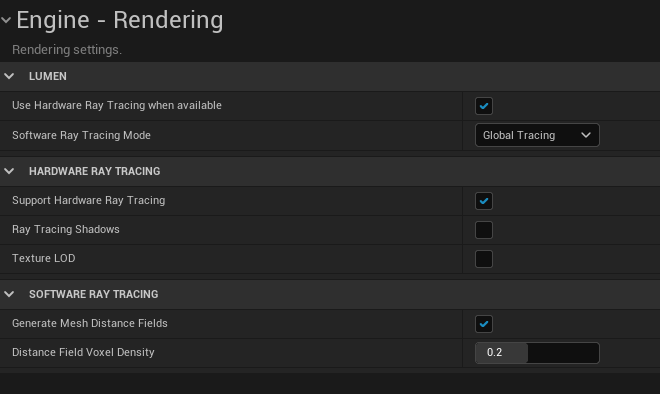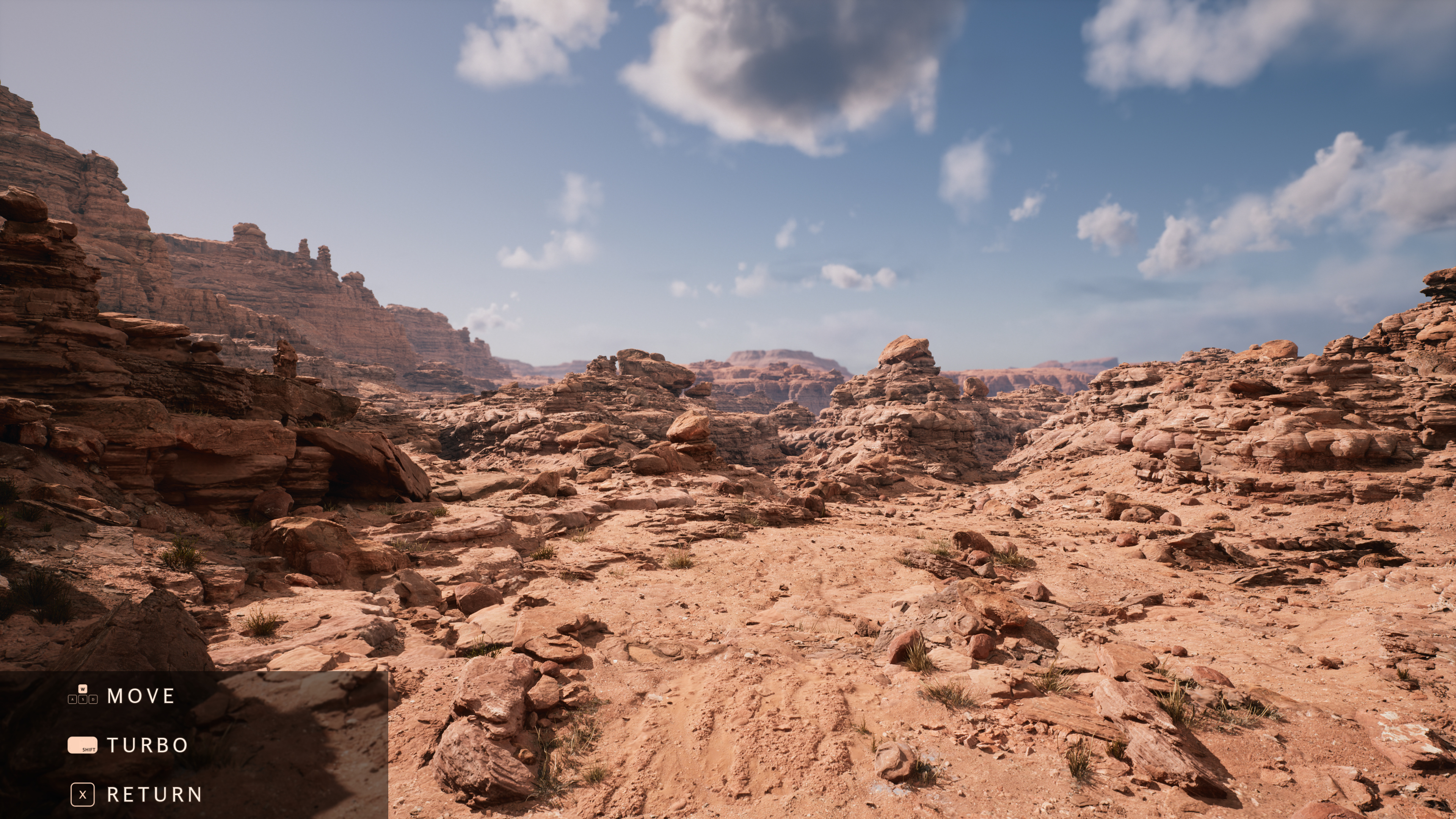You are using an out of date browser. It may not display this or other websites correctly.
You should upgrade or use an alternative browser.
You should upgrade or use an alternative browser.
Unreal Engine 5, [UE5 Developer Availability 2022-04-05]
- Thread starter mpg1
- Start date
I'ld wait a while before you write its obituaryEither this is a bug or Epic single handedly made Triangle Based Raytracing and dedicated RT acceleration obsolete. Because Lumen looks damn good. Maybe if you really search for differences and your name is Alex Battaglia, Hardware RT is still better in some scenarios, but seriously, if it tanks performance that much for no visual boost the average Joe can notice, Hardware-RT is completely useless when coupled with Lumen in UE5.
I havent really looked into it but I'ld wait until we see how it performs in different environments, eg a misty park with a river/lake and trees with leaves blowing around would be nice
hmmm apparently I'ld is not good english (it can be used though, eg shakespeare used it) Its what I've used my whole life. I'd it is from now on for me
Kise Ryota
Newcomer
For comparison 125MB/s is about 6 times faster than what Insomniac use (20MB/s) for their streaming engine on Spider-man (PS4).
That's not right. It's 20MB/s per tile (while moving fast through Manhattan), and they load 3 tiles for each 128m travelled.
I wonder if one can enable this when using main branch.
Certainly explains why the canyon didn't look like it was purely SSGI.
I wonder if one can enable this when using main branch.
Certainly explains why the canyon didn't look like it was purely SSGI.
There's definitely mentions of that in the shaders, not sure if that gets compiled though.
I'm curious to compile a distributable for myself but I always get some unnamed Windows SDK error. Does anyone have advice on which SDK that is?
I got 10.0.19042.0 installed and it didn't complain.
Off topic, but i'll never be able to access source. Github says my password is suddenly too lame and i have to change.
But first, solve some captcha... 10 times in a row i have to click an image where multiple dice (showing numbers or dots) sum up to 14.
I tried 3 times. Either i am too slow, or there is an error.
Obviously i'm too dumb for this world :/
But first, solve some captcha... 10 times in a row i have to click an image where multiple dice (showing numbers or dots) sum up to 14.
I tried 3 times. Either i am too slow, or there is an error.
Obviously i'm too dumb for this world :/
Frenetic Pony
Veteran
Lumen is way less interesting than I was hoping. Precalculated instead of proper texturing. There's papers, you can do volumetric UV mapping, in fact volumetric UV mapping has been around for years and is practically begging for use with virtualized geometry like nanite as well as signed distance fields.. And why do you have like 3 geometry representations and 2 texturing representations, and what's with the terrible trace distances?
UE5 feels... Nanite is awesome by itself, very efficient, runs damned well for me and seemingly for others to. The end result of Lumen is neat for artists once they get around the headaches. But glancing at the underpinnings reveals the Unreal Engine team as a kind of overly vast one all running different tracks and doing a lot of bodges to try and fit everything together, rather than any single person having an overall vision of what they're doing. Ah, well, large companies will be large companies, feels silly to whinge really.
Though that being said... how on earth are they planning to make Lumen work with foliage and multiple skinned characters? "Lumen runs slow without Nanite...". You know what I know the Lumen guys twitter. I'm sending him that volumetric UV paper and the one on detailed signed distance tracing. No more of this bodge nonsense.
UE5 feels... Nanite is awesome by itself, very efficient, runs damned well for me and seemingly for others to. The end result of Lumen is neat for artists once they get around the headaches. But glancing at the underpinnings reveals the Unreal Engine team as a kind of overly vast one all running different tracks and doing a lot of bodges to try and fit everything together, rather than any single person having an overall vision of what they're doing. Ah, well, large companies will be large companies, feels silly to whinge really.
Though that being said... how on earth are they planning to make Lumen work with foliage and multiple skinned characters? "Lumen runs slow without Nanite...". You know what I know the Lumen guys twitter. I'm sending him that volumetric UV paper and the one on detailed signed distance tracing. No more of this bodge nonsense.
... i'm no longer worried other engines would have issues to catch up. That's a very good thing.Lumen is way less interesting than I was hoping. Precalculated instead of proper texturing. There's papers, you can do volumetric UV mapping, in fact volumetric UV mapping has been around for years and is practically begging for use with virtualized geometry like nanite as well as signed distance fields.. And why do you have like 3 geometry representations and 2 texturing representations, and what's with the terrible trace distances?
UE5 feels... Nanite is awesome by itself, very efficient, runs damned well for me and seemingly for others to. The end result of Lumen is neat for artists once they get around the headaches. But glancing at the underpinnings reveals the Unreal Engine team as a kind of overly vast one all running different tracks and doing a lot of bodges to try and fit everything together, rather than any single person having an overall vision of what they're doing. Ah, well, large companies will be large companies, feels silly to whinge really.
Hardware RT Lumen is disabled by default btw, you have to enable these two settings from the project/engine settings to enable it:

Need to restart the project and it recompiles a bunch of shaders.
If it works how does it impact performance?
If it works how does it impact performance?
It greatly impacts performance without much visual gain, at least in this demo.
Software RT

Hardware RT

Seems to be greatly VRAM constrained with h/w RT enabled, maybe the 3090 will perform better with this enabled.
Lumen is way less interesting than I was hoping. Precalculated instead of proper texturing. There's papers, you can do volumetric UV mapping, in fact volumetric UV mapping has been around for years and is practically begging for use with virtualized geometry like nanite as well as signed distance fields.. And why do you have like 3 geometry representations and 2 texturing representations, and what's with the terrible trace distances?
UE5 feels... Nanite is awesome by itself, very efficient, runs damned well for me and seemingly for others to. The end result of Lumen is neat for artists once they get around the headaches. But glancing at the underpinnings reveals the Unreal Engine team as a kind of overly vast one all running different tracks and doing a lot of bodges to try and fit everything together, rather than any single person having an overall vision of what they're doing. Ah, well, large companies will be large companies, feels silly to whinge really.
Though that being said... how on earth are they planning to make Lumen work with foliage and multiple skinned characters? "Lumen runs slow without Nanite...". You know what I know the Lumen guys twitter. I'm sending him that volumetric UV paper and the one on detailed signed distance tracing. No more of this bodge nonsense.
I saw your tweet to Daniel Wright.
It greatly impacts performance without much visual gain, at least in this demo.
Software RT

Hardware RT

Seems to be greatly VRAM constrained with h/w RT enabled, maybe the 3090 will perform better with this enabled.
And the framerate on your 3080?
They use models of reduced detail, and it's all static / rigid transformations. So i guess HW RT should be much faster than software SDF after they optimize.Maybe it's just because the demo is not optimized for Hardware RT.
Question is if HW RT could be used for the full (or higher) detail meshes for shadows / reflections. I think it's possible with some limitations like using only close range around camera, which they already do with falling back to screenspace GI after 200m.
snc
Veteran
the whole idea of software sdf is that we know it not as accurate but just faster than more precise hw rt ;dThey use models of reduced detail, and it's all static / rigid transformations. So i guess HW RT should be much faster than software SDF after they optimize.
And the framerate on your 3080?
45-50 FPS to 20 or so, I need to check. The VRAM is fully saturated though so the GPU isn’t performing at its best here.
I have never used sphere tracing, and games like Claybook proof it's really fast.the whole idea of software sdf is that we know it not as accurate but just faster than more precise hw rt ;d
But i can't believe it beats HW RT in case the scene setup is ideal for that.
Notice, they also have to use kind of top level acceleration structure to find all those thousands of object SDF blocks. In UE4 they used a regular grid for that. No matter what, it inherits the same problems as any other raytracing solution, including incoherent memory access and divergence.
BVH is more work efficient than brute force SDF tracing. So at some point it always becomes faster. And with HW acceleration i would assume we are behind this point, otherwise my rant on DXR shall increase even more...
45-50 FPS to 20 or so, I need to check. The VRAM is fully saturated though so the GPU isn’t performing at its best here.
Another reason to finally implement Sampler Feedback, it would free up a ton of VRAM for Raytracing. It's really strange how they are completely ignoring DX12 Ultimate.
Similar threads
- Replies
- 24
- Views
- 4K
- Replies
- 104
- Views
- 18K
- Replies
- 0
- Views
- 927
- Locked
- Replies
- 260
- Views
- 22K
